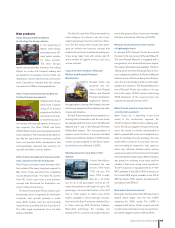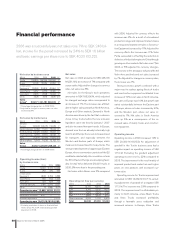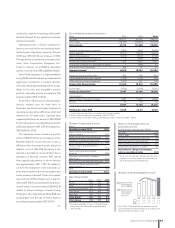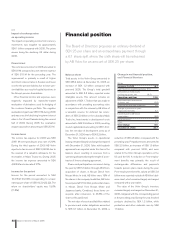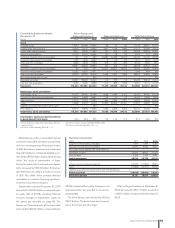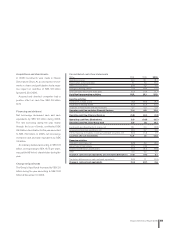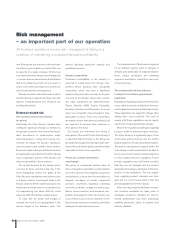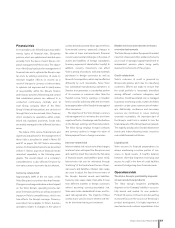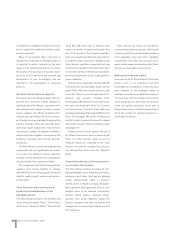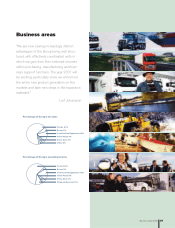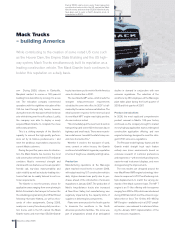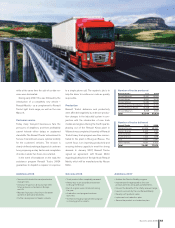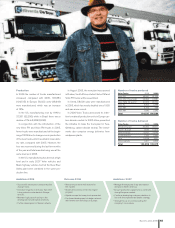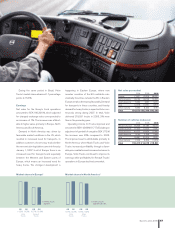Volvo 2006 Annual Report Download - page 61
Download and view the complete annual report
Please find page 61 of the 2006 Volvo annual report below. You can navigate through the pages in the report by either clicking on the pages listed below, or by using the keyword search tool below to find specific information within the annual report.
Financial risk
In its operations, the Volvo Group is exposed to
various types of financial risks. Groupwide
policies, which are updated and decided upon
annually, form the basis of each Group com-
pany’s management of these risks. The object-
ives of the Group’s policies for management of
financial risks are to optimize the Group’s capi-
tal costs by utilizing economies of scale, to
minimize negative effects on income as a
result of changes in currency or interest rates,
to optimize risk exposure and to clarify areas
of responsibility within the Group’s finance
and treasury activities. Monitoring and control
that established policies are adhered to is
conducted continuously centrally and at
each Group company. Most of the Volvo
Group’s financial transactions are carried out
through Volvo’s in-house bank, Volvo Treasury,
which conducts its operations within estab-
lished risk mandates and limits. Credit risks
are mainly managed by the different business
areas.
The nature of the various financial risks and
objectives and policies for the management of
these risks is described in detail in Notes 36
and 37 on pages 131-137. Volvo’s accounting
policies for financial instruments are described
in Note 1. Various aspects of financial risk are
described separately in the following para-
graphs. The overall impact on a company’s
competitiveness is also affected however by
how various macro-economic factors interact.
Currency-related risk
Approximately 90% of the net sales of the
Volvo Group are in countries other than Sweden.
Changes in exchange rates have a direct impact
on the Volvo Group’s operating income, bal-
ance sheet and cash flow, as well as an indirect
impact on Volvo’s competitiveness, which over
time affects the Group’s earnings. Currency-
associated risk as applies to Volvo’s business
operations relates to changes in the value of
contracted and expected future payment flows
(commercial currency exposure), changes in
the value of loans and investments (financial
currency exposure) and changes in the value of
assets and liabilities of foreign subsidiaries
(currency exposure of shareholders’ equity). In
addition, currency movements can affect
Volvo’s pricing of products sold and materials
purchased in foreign currencies as well as
those of its competitors, which may be affected
differently by such movements. Since Volvo
has substantial manufacturing operations in
Sweden and generates a substantial portion
of its revenues in currencies other than the
Swedish krona, Volvo’s earnings in Swedish
kronor could be adversely affected short-term
by an appreciation of the Swedish krona against
other currencies.
The objective of the Volvo Group’s currency
risk management is to minimize the short-term
negative effects of exchange-rate fluctuations
on the Group’s earnings and financial position.
The Volvo Group employs forward contracts
and currency options to hedge the value of
future payment flows in foreign currencies.
Interest-related risk
Interest-related risk include risks that changes
in interest rates will impact the Group’s income
and cash flow (cash flow risks) or the fair value
of financial assets and liabilities (price risks).
Interest-rate risk can be minimized through
“matching” of the fixed interest terms of finan-
cial assets and liabilities. Interest rate swaps
are used to adjust the fixed interest terms of
the Group’s financial assets and liabilities.
Currency rate swaps make it possible to loan
from different markets in foreign currencies
without assuming currency-associated risk.
Volvo also holds standardized futures and for-
ward rate agreements. The majority of these
contracts are used to ensure interest rate lev-
els for short-term loaning or investment.
Market risk from investments in shares
or similar instruments
The Volvo Group is indirectly exposed to market
risks from shares and other similar instruments
as a result of managed capital transferred to
independent pension plans being partly
invested in instruments of these types.
Credit-related risk
Volvo’s extension of credit is governed by
Group-wide policies and rules for classifying
customers. Efforts are made to ensure that
the credit portfolio is reasonably diversified
among different customer categories and
industries. Credit-associated risk is managed
by actively monitoring credit, routines for follow
up and in certain cases repossession of mater-
ials. Additionally, continuous and necessary
reserves are monitored in cases involving
uncertain receivables. An important part of
the Group’s credit risk is related to how the
financial assets of the Group have been placed.
The majority are placed in Swedish Goverment
bonds and interest-bearing bonds issued by
real estate financial institutions.
Liquidity risk
Volvo ensures its financial preparedness by
always maintaining a certain portion of rev-
enues in liquid assets. A healthy balance
between short-and long-term borrowing and
access to credit in the form of credit facilities
are used to hedge long-term financial needs.
Operational risk
The Volvo Group’s profitability depends
on successful new products
The Volvo Group’s long-term profitability
depends on the Company’s ability to success-
fully launch and market its new products.
Product life cycles continue to shorten, putting
increased focus on the success of the Group’s
product development. It is highly important to
meet and exceed customer expectations to be
Board of Directors’ Report 2006 57




